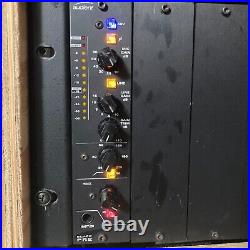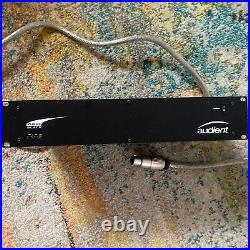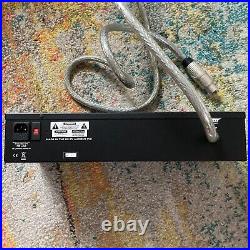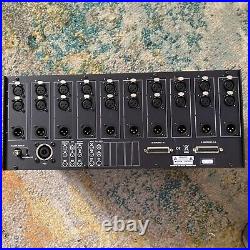Audient BR10






Just upgraded preamps, start your own Audient rack system! Such a sweet set, hope you enjoy it.
Like all the Black Series modules, the preamp is well laid out, and easy to understand, given the white labels on a black panel. Starting at the top, two illuminated push-buttons select +48V phantom power (blue) and a polarity inversion (switched via a relay). Next is a switched, rotary gain control for the mic input, providing gain between 10 and 60dB in decade increments. The microphone input uses the'A' socket on the rear panel. Next, another illuminated button (orange) selects the line input via another relay and another rotary switch provides gain from -10 to +15dB in 5dB steps.
The line input is connected via socket'B', so can be accessed easily from the multi-channel D-sub interface. The final control in this section is a continuous gain trim providing up to a further 10dB of gain, allowing the level of the selected input to be fine tuned, and affording a useful maximum 70dB of gain for the mic. Running vertically up the side of these controls is a 12-segment LED bar-graph, which shows the preamp's output level relative to the digital output of the Black-series A-D converter (if installed). In other words, the meter is calibrated in dB Full Scale, where 0dBFS equates to +18dBu (the European standard alignment level). Usefully, there's also a separate'Over' indicator that illuminates at +19dBu (1dB higher and 2dB below the preamp circuitry's actual clipping point at +21dBu).
The next section of the front panel provides a continuously variable high-pass filter (low cut), with a second-order slope (12dB/octave) and a turnover point that can be varied from 30 to 225Hz. Another illuminated push-button (orange) here switches the filter into circuit.
Next, we have the preamp's'quirky' feature - the HMX control. Audient describe this as adding a solid-state'triode' gain stage to enhance low-order harmonics. There is another illuminated push-button (red) to activate this feature and a rotary control scaled simply from 0 to 10. The higher the number, the more harmonic distortion is introduced and the richer (or more crunchy) the sound becomes. Lastly, a quarter-inch socket at the bottom of the panel provides an instrument or DI input. Plugging into the DI socket overrides the physical mic and line inputs but, rather cleverly, the mic and line gain stages can still be selected to process the DI input by using the Line switch in the usual way. This means there's a lot of gain available if needed, and you can choose whether to work with 10dB or 5dB increments! The DI input presents an input impedance of over half a MO, so there is no problem in loading guitar preamps.